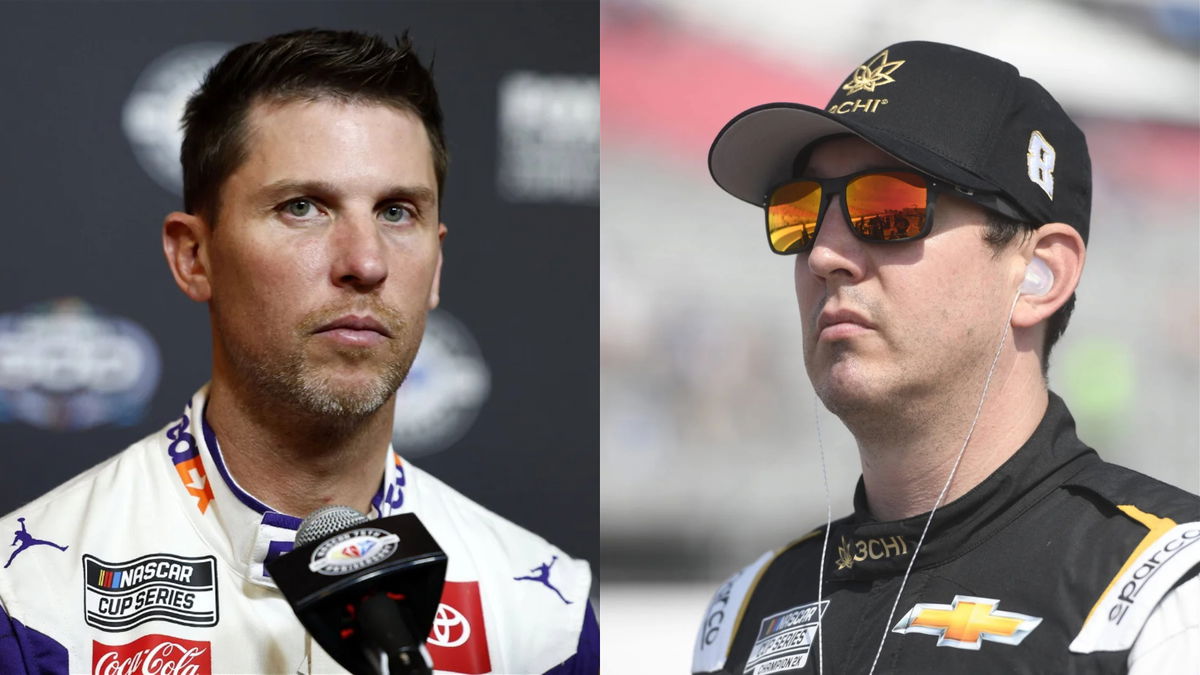
Imago
Denny Hamlin, Kyle Busch | Image Credits: Imago

Imago
Denny Hamlin, Kyle Busch | Image Credits: Imago
Kyle Busch is beyond frustrated. Suffering from an 82-race winless streak—his second-straight year without a Cup Series win—the Richard Childress Racing driver’s exasperation was amply visible when he complained on the radio in Kansas in May, “These cars suck so bad. Thank you, NASCAR.” Unfortunately, things have hardly looked up.
Watch What’s Trending Now!
While the #8 team did come close to winning at the Circuit of the Americas (COTA) back in March, with Busch leading 42 of 95 laps, he ultimately finished fifth after getting passed by Christopher Bell. The Chicago Street Race also proved to be another success for Busch who, despite spinning early in the race and receiving a penalty on Lap 38 for driving through more than three pit boxes, finished with a P5. But that was six races ago. And in the time that has elapsed, the veteran racer has only struggled—a recently disappointing show of which even had former teammate, Denny Hamlin, confused.
During the latest episode of the Actions Detrimental podcast titled, ‘This Was Like Gen 5 Racing’, the Joe Gibbs Racing driver laid bare his genuine confusion and concern over Busch’s behavior at Richmond Raceway. “I was gonna text him and say… are you okay?…like… You know… hey bud… how you doing? Doing okay?” Hamlin said, emphasizing that “it just doesn’t look right” seeing Busch, usually a precise and controlled driver, involved in such relentless chaos. Hamlin pointed out that Busch’s maneuvers under caution and during the incident were visibly frantic, indicating a loss of the usual control expected from the veteran racer.
ADVERTISEMENT
Notably, the two-time Cup Series champion was involved in a multi-car crash on Lap 198, that started with him contacing Chase Briscoe’s right-rear entering Turn 3 during a three-wide battle. As Briscoe lost control and spun into oncoming traffic, Hamlin, Justin Haley, Brad Keselowski, Ross Chastain, Ty Dillon, Cole Custer, and Erik Jones, and Busch himself became part of the 11-car pileup. Additionally, as Chase Elliott tried to sneak past, he was also hit by the No. 8, sending him nose-first into the outside wall, resulting in the Hendrick Motorsports racer’s first DNF this season. The JGR racer said Busch “swiped out cars and then clipped the nine [Chase Elliott] on the way out.”
But he also defended the veteran, saying, “[Busch] wasn’t told about the nine until the last second… at that point he’s just trying to get clear of the mayhem,” understanding the split-second decisions Busch had to make amid intense traffic and relentless pressure. Yet, Hamlin’s candid reflections underscore both his concern for his teammate’s state and the volatile, high-stakes environment that fuels NASCAR’s toughest races. But that wasn’t all to Busch tactics at Richmond…
Hamlin also recounted Busch’s unusual contact under caution when he “door slammed” into Hamlin’s car, an incident that immediately caught the latter off guard.
ADVERTISEMENT
Challenging the “Bright Light Theory” amid NASCAR’s pressure cooker
Denny Hamlin’s reflections on Kyle Busch’s Richmond wreck come amid broader discussions he’s been vocal about regarding NASCAR’s intense competitive environment, especially the playoff format that often amplifies pressure to near-breaking points. In his recent comments addressing the “Bright Light Theory” a viral notion that the championship goes not to the best driver but to the best team that performs under maximum pressure and spotlight, Hamlin pushed back hard, calling it a PR-driven oversimplification that doesn’t capture the real challenges drivers face.
ADVERTISEMENT
On his “Actions Detrimental” podcast, Hamlin illustrated his stance by giving a real-world example. He mentioned Corey Heim, a dominant driver in the truck series with multiple wins and a strong playoff point lead. Yet, he could be derailed by uncontrollable issues like a flat tire or bad luck. “Did he not perform when the lights were brightest? No, he just got unlucky,” Hamlin explained, highlighting that NASCAR’s win-or-go-home playoff structure injects a level of unpredictability and luck that overshadows pure driving skill and consistency.
“This whole ‘when the lights are bright,’ the pressure like that seems like it’s a company talking point… but realistically, I think the fan base is kind of had enough of it,” Hamlin said. This perspective dovetails with Hamlin’s concern about Busch’s Richmond night; the intense pressure and unpredictable chaos of the playoffs don’t just test technical skill, but mental resilience, decision-making under duress, and often, sheer luck.
ADVERTISEMENT
ADVERTISEMENT
ADVERTISEMENT

